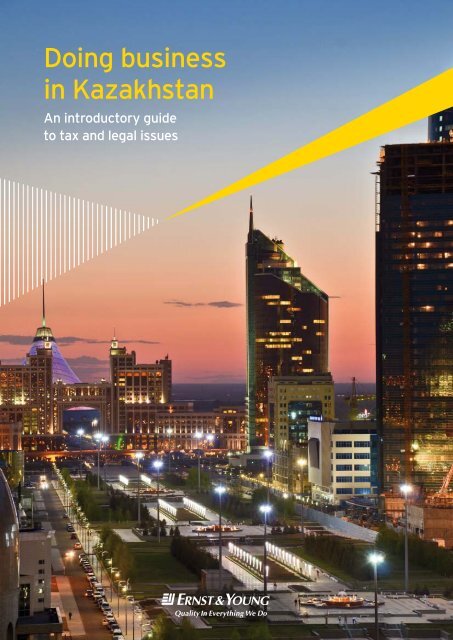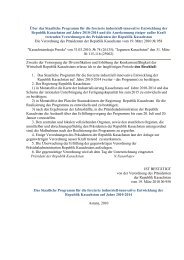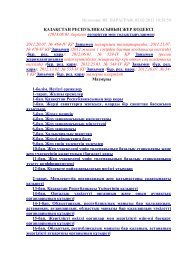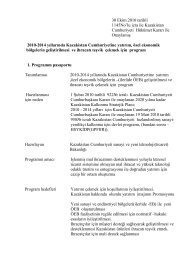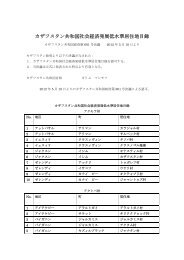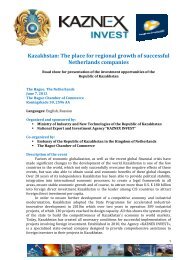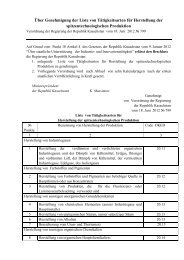Doing business in Kazakhstan - Invest In Kazakhstan
Doing business in Kazakhstan - Invest In Kazakhstan
Doing business in Kazakhstan - Invest In Kazakhstan
You also want an ePaper? Increase the reach of your titles
YUMPU automatically turns print PDFs into web optimized ePapers that Google loves.
¼ ²·¸¹¨º»®b¯TABELA 4 - Produção de Leite por Tipo, Estado de São Paulo, 2000 a 2002°±²³´µAnoTipo A Tipo B Tipo C Total1.000 litros ∆ 1 % 1.000 litros ∆ 1 % 1.000 litros ∆ 1 % 1.000 litros ∆ 1 %2000 49.124 - 345.403 - 1.545.698 - 1.940.225 -2001 2 53.968 9,86 337.415 - 2,31 1.585.372 2,57 1.976.755 1,882001 3 34.343 - 30,09 353.644 2,39 1.588.439 2,77 1.976.426 1,872002 2 34.112 - 0,67 324.576 - 8,22 1.480.361 - 6,80 1.839.049 - 6,952002 3 39.063 13,74 344.971 - 2,45 1.619.950 1,98 2.003.984 1,391 Variação percentual de crescimento anual calculada em relação ao levantamento de novembro.2 Previsão do levantamento de junho dos respectivos anos.3 Estimativa do levantamento de novembro dos respectivos anos.Fonte: <strong>In</strong>formações Estatísticas da Agricultura: Anuário IEA, 2000/01. São Paulo: IEA, 2001/02 (Sér. <strong>in</strong>f. estat. agric.) e LevantamentoIEA/CATI de jun. 2001, jun. e nov. 2002.TABELA 5 - Produção de Aves para Postura, Estado de São Paulo, 2000 a 2002 1AnoPlantel(cabeça)Produção de ovos(1.000 dúzias/ano)∆ 2 % da produção2000 33.656.206 724.4162001 3 34.685.243 758.039 4,642002 3 36.661.035 765.235 0,951 As estatísticas da produção de aves para postura passaram por uma revisão, estando disponíveis apenas para o levantamento denovembro.2 Variação percentual de crescimento anual calculada em relação ao levantamento de novembro.3 Estimativa do levantamento de novembro dos respectivos anos.Fonte: Levantamento IEA/CATI de nov. de 2000, 2001 e 2002.TABELA 6 - Produção de Aves para Corte, Estado de São Paulo, 2000 a 2002AnoRebanho(cabeça)Enviadas ao abate(cabeça)Produção de carne(t)∆ 1 %2000 135.838.316 483.873.393 1.024.170 -2001 2 138.979.489 536.644.662 1.087.962 6,232001 3 152.015.552 617.308.322 1.243.836 21,452002 2 149.796.969 511.308.338 1.055.643 - 15,132002 3 148.991.286 504.288.751 1.029.458 - 17,241 Variação percentual de crescimento anual calculada em relação ao levantamento de novembro.2 Previsão do levantamento de junho dos respectivos anos.3 Estimativa do levantamento de novembro dos respectivos anos.Fonte: <strong>In</strong>formações Estatísticas da Agricultura: Anuário IEA, 2000/01. São Paulo: IEA, 2001/02 (Sér. <strong>in</strong>f. estat. agric.) e LevantamentoIEA/CATI de jun. 2001, jun. e nov. 2002.TABELA 7 - Número de Suínos, Estado de São Paulo, 2000 a 2002AnoRebanho atualcabeças ∆ 1 %Enviado aoProdução de carneabate tonelada ∆ 1 %Taxa de abate2000 1.529.695 1.481.767 133.360 96,872001 2 1.413.247 - 7,61 1.341.305 128.873 - 3,26 94,912001 3 1.684.335 10,10 1.670.258 149.122 11,82 99,162002 2 1.368.757 - 18,74 1.428.027 130.205 - 12,69 104,332002 3 1.378.263 -18,17 1.485.624 137.104 -8,06 107,791 Variação percentual de crescimento anual calculada em relação ao levantamento de novembro.2 Previsão do levantamento de junho dos respectivos anos.3 Estimativas do levantamento de novembro dos respectivos anos.Fonte: <strong>In</strong>formações Estatísticas da Agricultura: Anuário IEA, 2000/01. São Paulo: IEA, 2001/02 (Sér. <strong>in</strong>f. estat. agric.) e LevantamentoIEA/CATI de jun. 2001, jun. e nov. 2002.(%)— ˜£ š¦›¨œžŸ ¡¢£š˜£¤¦œ¥£¡ ¦§¨¦© ª «£«¦"˜£ª «¦œ›¨ª¦¬%&«'ª
Section 1Welcometo <strong>Kazakhstan</strong>Highlights• <strong>Kazakhstan</strong> posted an annualaverage GDP growth rate of 8.3%from 2001—2010, with GDP <strong>in</strong> 2010reach<strong>in</strong>g US$148.1 billion (US$9,070per capita). After a sharp decl<strong>in</strong>eof GDP growth from 8.9% <strong>in</strong> 2007to 1.2% <strong>in</strong> 2009, the economy of<strong>Kazakhstan</strong> demonstrated a positivetrend. <strong>In</strong> 2010 and January—June2011, GDP growth reached 7.3% and7.1%, respectively. <strong>In</strong> June 2011, thegovernment of <strong>Kazakhstan</strong> approvedan official annual average GDPforecast for 2011—2015 at 7%.• Dom<strong>in</strong>ant sources of national revenuerema<strong>in</strong> the oil and gas and m<strong>in</strong><strong>in</strong>gsectors, but <strong>Kazakhstan</strong> cont<strong>in</strong>uesto diversify its economy.• <strong>Kazakhstan</strong> benefits from robust FDI,given its <strong>in</strong>vestor-friendly approach.• Political stability, coupled with a strongvision <strong>in</strong> the formulation and executionof the country’s economic development,has positioned <strong>Kazakhstan</strong> as theregional leader <strong>in</strong> Central Asia.• Significant market size due tothe formation of the CustomsUnion between Russia, Belarusand <strong>Kazakhstan</strong> that accounts for170 million people.• <strong>Kazakhstan</strong> is committed to regionaland <strong>in</strong>ternational cooperation andaims to become a country with ahigh-<strong>in</strong>come economy (US$15,000GDP per capita by the end of 2015).2 <strong>Do<strong>in</strong>g</strong> <strong>bus<strong>in</strong>ess</strong> <strong>in</strong> <strong>Kazakhstan</strong>
Governance structureThe Republic of <strong>Kazakhstan</strong> ga<strong>in</strong>ed its<strong>in</strong>dependence on 16 December 1991.Accord<strong>in</strong>g to the constitution adoptedon 30 August 1995, <strong>Kazakhstan</strong> is ademocratic, secular, legal and social state.State power is divided between legislative,executive and judicial authorities.<strong>Kazakhstan</strong> is a unitary state withpresidential rule. The President of therepublic is Nursultan Nazarbayev, who waselected by popular vote for a five-year term.The last election was held <strong>in</strong> April 2011; thenext is to be held <strong>in</strong> 2016.Public holidaysThe follow<strong>in</strong>g table presents the officialpublic holidays <strong>in</strong> <strong>Kazakhstan</strong>.HolidayNew Year’s Holidays<strong>In</strong>ternationalWomen’s DayNauryz Meyrami<strong>Kazakhstan</strong>i PeopleUnity DayVictory DayCapital DayDate1—2 January8 March21—23 March1 May9 May6 JulyTime<strong>Kazakhstan</strong>’s time zones progress fromfive hours ahead of Greenwich Mean Time(GMT) <strong>in</strong> the western part of the countryto six hours ahead of GMT <strong>in</strong> the rest of theregions. Astana and Almaty are six hoursahead of GMT and two hours ahead ofMoscow.Bus<strong>in</strong>ess hoursKazakh offices are generally open from9:00 a.m. to 6:00 p.m., Monday to Friday,and closed Saturdays and Sundays.The Parliament of <strong>Kazakhstan</strong> is thesupreme representative body, whichperforms legislative functions and consistsof two chambers: the Senate and Majilis.The government of <strong>Kazakhstan</strong> acts as asupreme executive body headed by PrimeM<strong>in</strong>ister. Judicial authority is vested <strong>in</strong> theSupreme Court.Constitution Day<strong>In</strong>dependence Day30 August16—17 December4 <strong>Do<strong>in</strong>g</strong> <strong>bus<strong>in</strong>ess</strong> <strong>in</strong> <strong>Kazakhstan</strong>
<strong>Kazakhstan</strong>Area:2,724,900 square kilometers (1,052,085 square miles)Population: 16.4 million people as of 1 January 2011Capital: Astana (697,000 people as of 1 January 2011)Language:Currency:Kazakh is the official language,Russian is a means of <strong>in</strong>ter-ethnic communicationKazakh tenge (KZT)AstanaTime differences between Astana and selected citiesW<strong>in</strong>ter,hours—11—6—5—3—2—1+3New YorkLondonParisKyivM<strong>in</strong>skBakuMoscowSt. PetersburgTbilisiYerevanAtyrauAktobeAktauTashkentAstanaAlmatyTokyoSummer,hours—10—5—4—3—2—1+3New YorkLondonParisKyivM<strong>in</strong>skMoscowSt. PetersburgTbilisiAtyrauAktobeAktauBakuYerevanTashkentAstanaAlmatyTokyo<strong>Do<strong>in</strong>g</strong> <strong>bus<strong>in</strong>ess</strong> <strong>in</strong> <strong>Kazakhstan</strong>5
Section 2Our top 10tax and legal tips<strong>In</strong> this section, we set out the top tax and legal tipsthat <strong>in</strong>vestors should be aware of.Tax tips1. Tax laws <strong>in</strong> <strong>Kazakhstan</strong> have changedregularly <strong>in</strong> recent years. It is thereforeimportant that tax plann<strong>in</strong>g is robust,i.e. it can cope with changes <strong>in</strong> taxlaw and can be restructured withoutsignificant tax costs.2. Corporate and <strong>In</strong>dividual <strong>in</strong>cometax rates <strong>in</strong> <strong>Kazakhstan</strong> are low by<strong>in</strong>ternational standards. However,penalties for non-payment andnon-report<strong>in</strong>g, whether <strong>in</strong>tentionalor not, are high. The first focus oftax plann<strong>in</strong>g <strong>in</strong> <strong>Kazakhstan</strong> shouldbe to ensure that all tax that oughtto be paid <strong>in</strong> <strong>Kazakhstan</strong> is paid andreported. <strong>In</strong> addition, <strong>Kazakhstan</strong>is a documentation-driven place.Therefore, keep<strong>in</strong>g documentation<strong>in</strong> order (<strong>in</strong>clud<strong>in</strong>g supportdocumentation) is of paramountimportance.3. The scope of withhold<strong>in</strong>g taxes oncross-border payments is wide andrates are high (even sometimeswhen the recipient has never entered<strong>Kazakhstan</strong>). These can be totallyavoided <strong>in</strong> many cases provided thatthe transactions are structured us<strong>in</strong>ga tax treaty country and the payer hasall of the necessary documentation<strong>in</strong> place. Otherwise tax will bewithheld, and gett<strong>in</strong>g a refund maybe an uncerta<strong>in</strong> process. Moreover,<strong>Kazakhstan</strong> has a unique position <strong>in</strong>regard to transfer pric<strong>in</strong>g: transferpric<strong>in</strong>g control potentially applies to allcross-border transactions regardlessof whether the parties are <strong>in</strong> any wayrelated or not.4. There are many downsides to deal<strong>in</strong>gwith tax havens when structur<strong>in</strong>gcross-border <strong>in</strong>vestments ortransactions <strong>in</strong> <strong>Kazakhstan</strong>. Thus, taxhavens should not usually form part oftax plann<strong>in</strong>g <strong>in</strong> <strong>Kazakhstan</strong>.5. The rules for determ<strong>in</strong><strong>in</strong>g whethera taxable presence for corporate<strong>in</strong>come tax (CIT) <strong>in</strong> <strong>Kazakhstan</strong>(a “permanent establishment”) existsfor a <strong>bus<strong>in</strong>ess</strong> deal<strong>in</strong>g with <strong>Kazakhstan</strong>are very wide and can apply to wholegroups of companies collectivelyif their total presence exceeds sixmonths <strong>in</strong> country. Some but not allof <strong>Kazakhstan</strong>’s tax treaties protectaga<strong>in</strong>st this. Therefore, if us<strong>in</strong>g morethan one group entity to do <strong>bus<strong>in</strong>ess</strong>with <strong>Kazakhstan</strong>, the position of allentities <strong>in</strong>volved must be reviewedcollectively.6. The rules for determ<strong>in</strong><strong>in</strong>g whether ataxable presence exists for VAT are<strong>in</strong>dependent of the rules for CIT, andthe penalties for breaches can bedraconian. Never forget to considerVAT separately when th<strong>in</strong>k<strong>in</strong>g aboutwhether you have a taxable presence<strong>in</strong> <strong>Kazakhstan</strong>.7. For f<strong>in</strong>anc<strong>in</strong>g <strong>in</strong>vestments, there is abasic 6 to 1 debt equity ratio (9 to 1for banks), while from 2012 the ratiowill be 4 to 1 (7 to 1 for banks). An<strong>in</strong>vestor will at best pay 10% WHTon cross-border <strong>in</strong>terest (based on adouble tax treaty) and get at best aCIT deduction at 20%. Furthermore,exchange ga<strong>in</strong>s and losses on loans arerecognized for tax purposes.8. There is a safe harbor which wouldavoid a deemed taxable presencefor an entity that seconds staff towork <strong>in</strong> <strong>Kazakhstan</strong>. Provided thearrangements are properly structured,this is likely to be more tax-efficientthan us<strong>in</strong>g those same staff to provideconsultancy or other services.9. Branch profit tax applies to allpermanent establishments of foreignlegal entities at a general rate of 15%.It is usually reduced by tax treaties.There is an equivalent tax on dividendsat the same general rates and alsoreduced by treaties. <strong>In</strong> the case ofdividends the rate is zero after the<strong>in</strong>vestment has been held for threeyears (except for <strong>in</strong>vestments <strong>in</strong>to oiland gas or m<strong>in</strong><strong>in</strong>g).10. Capital ga<strong>in</strong>s tax on exit<strong>in</strong>g from an<strong>in</strong>vestment <strong>in</strong> <strong>Kazakhstan</strong> can belegitimately avoided <strong>in</strong> many cases,provided that the correct structur<strong>in</strong>gis used when the <strong>in</strong>vestment is firstmade. How onerous the structur<strong>in</strong>gwould be depends on the nature of theasset.6 <strong>Do<strong>in</strong>g</strong> <strong>bus<strong>in</strong>ess</strong> <strong>in</strong> <strong>Kazakhstan</strong>
Legal tips1. Most <strong>in</strong>vestors use a <strong>Kazakhstan</strong>limited liability partnership (LLP)as their <strong>in</strong>vestment vehicle.2. Settlements between residents of<strong>Kazakhstan</strong> (legal entities and citizens)must be performed <strong>in</strong> Kazakh tenge.Settlements between nonresidents(legal entities and citizens) and<strong>Kazakhstan</strong>i residents may generally beperformed <strong>in</strong> any currency.3. The range of <strong>bus<strong>in</strong>ess</strong> and professionalactivities that require a license is verybroad and it is important for <strong>in</strong>vestorsto determ<strong>in</strong>e whether they need alicense beforehand. The penalties fornot hav<strong>in</strong>g licenses can be significant.4. Obta<strong>in</strong><strong>in</strong>g work permits is a rathersophisticated process. Thus, it isimportant to plan this process well <strong>in</strong>advance.5. Us<strong>in</strong>g “brass plate” legal addressesis not sufficient <strong>in</strong> practice. Theauthorities will expect an <strong>in</strong>vestor tohave some presence at its registeredlegal address <strong>in</strong> <strong>Kazakhstan</strong>.6. <strong>Kazakhstan</strong> is very formalistic <strong>in</strong> manyaspects. <strong>In</strong> most cases, a company’srepresentatives should have powerof attorney for their actions and willregularly be required to refer to it, forexample when sign<strong>in</strong>g contracts.7. Local content is very important form<strong>in</strong><strong>in</strong>g and oil and gas companies andtheir subcontractors, and is constantlybe<strong>in</strong>g monitored by the stateauthorities.8. Kazakh is the state language of<strong>Kazakhstan</strong>. Russian is an officiallanguage and also may be usedequally with Kazakh. English is notrecognized as a legal language forofficial purposes. Thus, Englishdocuments will need to be translated.Where necessary, translations must benotarized.9. For commercial contracts <strong>Kazakhstan</strong>does, generally, permit the use offoreign law as the govern<strong>in</strong>g one,except for subsoil use contracts withthe state and foundation agreementsof a <strong>Kazakhstan</strong> legal entity andagreements on transfer of participationshares <strong>in</strong> such a legal entity.10. <strong>In</strong>ternational arbitration is not usuallyavailable for contracts between Kazakhlegal entities.Should you need more <strong>in</strong>formation on any of these issues, Ernst & Young will be happy toassist you with services <strong>in</strong> the follow<strong>in</strong>g areas:1. Tax plann<strong>in</strong>g and compliance, both <strong>in</strong> <strong>Kazakhstan</strong> and <strong>in</strong>ternationally2. Bus<strong>in</strong>ess account<strong>in</strong>g3. A full range of legal consultancy services <strong>in</strong> <strong>Kazakhstan</strong>, as well as tax litigation services4. Transaction advisory services and legal and tax due diligence5. Migration support and performance and reward plann<strong>in</strong>g6. Assurance services.<strong>Do<strong>in</strong>g</strong> <strong>bus<strong>in</strong>ess</strong> <strong>in</strong> <strong>Kazakhstan</strong>7
8 <strong>Do<strong>in</strong>g</strong> <strong>bus<strong>in</strong>ess</strong> <strong>in</strong> <strong>Kazakhstan</strong>
Section 3Gett<strong>in</strong>g startedArriv<strong>in</strong>g <strong>in</strong> <strong>Kazakhstan</strong>Citizens of most foreign countries will needvisas to visit <strong>Kazakhstan</strong>.Passports should be valid for at least sixmonths after the visa expiration date.The most popular visas are <strong>in</strong>vestor,<strong>bus<strong>in</strong>ess</strong> and work visas. These visas areissued for one, two, three or multipleentries and are valid for up to three years.<strong><strong>In</strong>vest</strong>or visas are issued to managementof foreign companies, which carry out<strong>in</strong>vestment activities <strong>in</strong> <strong>Kazakhstan</strong>, andto participants <strong>in</strong> the Regional F<strong>in</strong>ancialCentre of Almaty City (“RFCA”) as well asto their family members.Work visas are issued to foreign <strong>in</strong>dividualsarriv<strong>in</strong>g <strong>in</strong> <strong>Kazakhstan</strong> for employment,as well as to non-work<strong>in</strong>g members oftheir families. A work permit should besubmitted to obta<strong>in</strong> a work visa. See theWork permit section below for details.Bus<strong>in</strong>ess visas are issued to foreign<strong>in</strong>dividuals arriv<strong>in</strong>g <strong>in</strong> <strong>Kazakhstan</strong> for<strong>bus<strong>in</strong>ess</strong> purposes (e.g., <strong>bus<strong>in</strong>ess</strong> trip,negotiations, enter<strong>in</strong>g <strong>in</strong>to contracts,provision of consultancy or audit services,participation <strong>in</strong> conferences, symposiums,forums, exhibitions, concerts, cultural,scientific, sport and other events, etc.).<strong>In</strong> the territory of <strong>Kazakhstan</strong> visas areissued by the Department of ConsularService of the <strong>Kazakhstan</strong> M<strong>in</strong>istry ofForeign Affairs and abroad by <strong>Kazakhstan</strong>consular establishments (e.g. theConsular Department of the Embassyof <strong>Kazakhstan</strong>). Generally, visas areissued based on a letter of <strong>in</strong>vitation bya local Kazakh company or a branch/representative office of a foreign companysubmitted to the Department of ConsularService of the M<strong>in</strong>istry of Foreign Affairsof the Republic of <strong>Kazakhstan</strong>. The fee forissu<strong>in</strong>g a visa ranges from US$10 to 400,depend<strong>in</strong>g on the country of residenceof the <strong>in</strong>vited person and the type of visasought. The term for issuance of a visashould not exceed five work<strong>in</strong>g days.A letter of <strong>in</strong>vitation is not required fora s<strong>in</strong>gle diplomatic, official, <strong>bus<strong>in</strong>ess</strong>or private visa for citizens of certa<strong>in</strong>countries, such as Austria, Belgium, GreatBrita<strong>in</strong>, Greece, Italy, France, S<strong>in</strong>gapore,the United States. This visa is issued basedon a written application submitted by aforeign <strong>in</strong>dividual to the Kazakh consularestablishment <strong>in</strong> the respective countryor to the Department of Consular Serviceof the M<strong>in</strong>istry of Foreign Affairs of theRepublic of <strong>Kazakhstan</strong>.Foreign <strong>in</strong>dividuals arriv<strong>in</strong>g <strong>in</strong> <strong>Kazakhstan</strong>are registered by mak<strong>in</strong>g a registrationrecord <strong>in</strong> their migration card, except forthose com<strong>in</strong>g under <strong>in</strong>vestor visas. Theseforeign <strong>in</strong>dividuals are registered by mak<strong>in</strong>ga record <strong>in</strong> the passport. Depend<strong>in</strong>g on thevisa category and ground for its issuance,the registration is made by the Kazakhconsular establishment when issu<strong>in</strong>g a visa,border control authority when cross<strong>in</strong>g theborder or migration police with<strong>in</strong> five daysupon arrival of a foreign <strong>in</strong>dividual.Should you require assistance <strong>in</strong> plann<strong>in</strong>gand manag<strong>in</strong>g your human capital needs,Ernst & Young can assist with obta<strong>in</strong><strong>in</strong>gwork permits for foreign employees, taxregistration and compliance for expatriate<strong>in</strong>dividuals.<strong>Do<strong>in</strong>g</strong> <strong>bus<strong>in</strong>ess</strong> <strong>in</strong> <strong>Kazakhstan</strong>9
Should you require more <strong>in</strong>formation on thenature and use of various <strong>bus<strong>in</strong>ess</strong> entities <strong>in</strong><strong>Kazakhstan</strong>, Ernst & Young offers legal andtax advice on how to structure <strong>bus<strong>in</strong>ess</strong> <strong>in</strong><strong>Kazakhstan</strong>, as well as the full range of legalformation and registration services.Types of legalentities<strong>In</strong> accordance with the provisions of theCivil Code 1 of the Republic of <strong>Kazakhstan</strong>,foreign and local <strong>in</strong>vestors may do <strong>bus<strong>in</strong>ess</strong><strong>in</strong> <strong>Kazakhstan</strong> through a number oforganizational and legal forms, <strong>in</strong>clud<strong>in</strong>ggeneral partnerships, limited liabilitypartnerships, partnerships with additionalliability, commandite partnerships,jo<strong>in</strong>t stock companies (corporations)and representative and branch offices.Branches and representative offices offoreign legal entities are also common.<strong>In</strong> the outl<strong>in</strong>e below, we expand on the fourtypes of <strong>bus<strong>in</strong>ess</strong> vehicles which are mostwidely used <strong>in</strong> practice.Limited liability partnerships (LLP)LLP are very similar to jo<strong>in</strong>t stockcompanies. The ma<strong>in</strong> difference betweenthe two entities is that an LLP does notissue shares; <strong>in</strong>stead, participants have<strong>in</strong>terests <strong>in</strong> the partnership. An LLP maybe formed by one or more participants.Generally, the participants of an LLP arenot liable for the debts of the LLP beyondthe value of their contributions. The CivilCode provides a number of exceptions tothis rule.The m<strong>in</strong>imum capital requirement for anLLP is 100 times the MCI 2 (approximatelyUS$1,000). For small-sized <strong>bus<strong>in</strong>ess</strong>entities the m<strong>in</strong>imum capital requirementis KZT100 (approximately US$0.7).Participants’ <strong>in</strong>terests are proportional totheir contributions to the charter capitalunless the foundation documents provideotherwise. Participants have preemptionrights on each other’s <strong>in</strong>terests.Importantly, <strong>in</strong> <strong>Kazakhstan</strong>, limited liabilitypartnerships are separate legal entitieswhich are dist<strong>in</strong>ct from their participants.As a legal entity, a limited liabilitypartnership is subject to state registrationand taxation <strong>in</strong> its own right; i.e., it is nottax-transparent.Jo<strong>in</strong>t stock companies (JSC)A JSC is a legal entity that is separateand dist<strong>in</strong>ct from its shareholders, i.e.shareholders are not liable for JSCliabilities. It may have one or moreshareholders. The m<strong>in</strong>imum capitalrequired for a JSC is 50,000 times MCI(approximately US$500,000).Representative office<strong>Kazakhstan</strong>’s law allows a foreign companyto establish a representative office <strong>in</strong><strong>Kazakhstan</strong> <strong>in</strong> order to represent its<strong>in</strong>terests on the territory of <strong>Kazakhstan</strong>.A representative office protects andrepresents the <strong>in</strong>terests of a foreign legalentity and carries out preparatory andauxiliary activities, such as market<strong>in</strong>g andadvertis<strong>in</strong>g. Generally, a representativeoffice may not conduct commercial activity.The representative office is not recognizedas a separate legal entity.BranchA branch is a subdivision of a foreignlegal entity that carries out all or part ofthe functions of the foreign entity and <strong>in</strong>particular can carry on commercial activity.A branch is not considered to be a legalentity separate from its foreign parentcompany (head office). However, branchesand representative offices must completestate registration.1 The Civil Code of the Republic of <strong>Kazakhstan</strong> dated 27 December 1994 (with amendments as of 22 July 2011).2 The Monthly calculation <strong>in</strong>dex (“MCI”) was established by the Law of the Republic of <strong>Kazakhstan</strong> “On Republic Budget for 2011—2013”.Start<strong>in</strong>g from 1 January 2011 MCI is KZT1,512.10 <strong>Do<strong>in</strong>g</strong> <strong>bus<strong>in</strong>ess</strong> <strong>in</strong> <strong>Kazakhstan</strong>
Establish<strong>in</strong>ga legal presenceAs a general rule, all legal entities,branches and representative offices<strong>in</strong> <strong>Kazakhstan</strong> are subject to stateregistration.State registrationState Registration <strong>in</strong> <strong>Kazakhstan</strong> isperformed based on a “one w<strong>in</strong>dow”pr<strong>in</strong>ciple: all the registration documentsshould be submitted to one state authority,the Public Service Center (TSON).<strong>In</strong> accordance with the law On StateRegistration, the procedure takes fromthree to 14 <strong>bus<strong>in</strong>ess</strong> days. The abovetimeframes do not <strong>in</strong>clude registration of alegal entity, branch or representative officewith the statistical and tax authorities. <strong>In</strong>practice the general registration term cantake up to one month and even longer.The legislation requires that a standard setof documents be submitted to completethe state registration of an entity. Hav<strong>in</strong>gall of the right documents is the key toa successful registration process. It isessential to ensure that the documentshave been duly signed, sealed, notarizedand legalized or apostilled if the documentsare executed abroad 3 , otherwise theregistration process may be considerablydelayed.The state registration fee is currentlyapproximately US$70.As soon as the state registration hasbeen completed, the entity should applyto obta<strong>in</strong> a seal from a local authorizedcompany. Such an authorized company willdesign and produce a seal and register itwith the Kazakh state authorities.Location (Legal address)The location of a legal entity is the address<strong>in</strong>dicated <strong>in</strong> its foundation (e.g. Charter)documents. <strong>In</strong> accordance with Kazakh law,the location of a legal entity is the placeof the legal entity’s permanent operat<strong>in</strong>gbody. The location plays an importantpart <strong>in</strong> a legal entity’s registration andother legal events, such as identificationof the court to which an appeal shouldbe submitted (legal suit is filed accord<strong>in</strong>gto the location) or tax authority throughwhich the taxes and other payments to thebudget will be paid.For tax proposes, the actual address of alegal entity should be the same as its placeof location. The tax authorities have a rightto conduct tax <strong>in</strong>spections to confirm theactual location of a taxpayer at the placeof location. If the tax authorities discoverthat a taxpayer is not present at the placeof location, they may impose adm<strong>in</strong>istrativeactions aga<strong>in</strong>st the taxpayer.Open<strong>in</strong>g a bank account —for companies and <strong>in</strong>dividualsBank accounts can be opened with alocal bank <strong>in</strong> <strong>Kazakhstan</strong> <strong>in</strong> the nationalcurrency, the tenge, and/or <strong>in</strong> a foreigncurrency.Branches and representative officesof foreign legal entities may opt to useoffshore (foreign) bank accounts.See the chapters on Bank regulations andCurrency regulations for details.Antimonopoly legislationAcquisition of more than 25% of shares/participation shares <strong>in</strong> a legal entity <strong>in</strong><strong>Kazakhstan</strong> (provided certa<strong>in</strong> criteriaare met) may be viewed by the Kazakhstate authorities as activities lead<strong>in</strong>g toeconomic concentration, which requireobta<strong>in</strong><strong>in</strong>g prior approval from theantimonopoly authorities. Accord<strong>in</strong>g tothe recent practice of the antimonopolyauthorities, creation of a legal entity witha potential purchase of more than 25%of shares/participation shares <strong>in</strong> such alegal entity is also treated as transactionlead<strong>in</strong>g to the economic concentration. <strong>In</strong>this respect, potential participants shouldobta<strong>in</strong> the consent of the antimonopolyauthorities.3 Requirement on legalization and apostillisation is not applicable to documents executed <strong>in</strong> countries which are parties to the respective<strong>in</strong>ternational treaties.<strong>Do<strong>in</strong>g</strong> <strong>bus<strong>in</strong>ess</strong> <strong>in</strong> <strong>Kazakhstan</strong>11
Categories of labor immigrants,permits and secondment issuesNew Law of the Republic of <strong>Kazakhstan</strong>“On Migration of Population” (the “NewLaw on Migration”) adopted on 22 July2011 establishes the follow<strong>in</strong>g categoriesof immigrants arriv<strong>in</strong>g for the laboractivities:• Foreign employees, i.e. immigrantsarrived or attracted by employers forconduct<strong>in</strong>g labor activities <strong>in</strong> <strong>Kazakhstan</strong>;• Bus<strong>in</strong>ess immigrants, i.e. immigrantsarrived for conduct<strong>in</strong>g entrepreneurialactivities <strong>in</strong> accordance with thelegislation of the Republic of <strong>Kazakhstan</strong>;• Seasonal foreign employees, i.e.immigrants attracted by employersfor conduct<strong>in</strong>g seasonal work whichis performed dur<strong>in</strong>g a def<strong>in</strong>ite period(season) <strong>in</strong> view of climate and othernatural conditions but for no more thanone year.The New Law on Migration establishesdef<strong>in</strong>ite conditions for the arrival andstay <strong>in</strong> <strong>Kazakhstan</strong> of each of the abovementionedcategories of labor immigrants,<strong>in</strong>clud<strong>in</strong>g, among other th<strong>in</strong>gs, (i)confirmation of their f<strong>in</strong>ancial solvencyallow<strong>in</strong>g them to leave <strong>Kazakhstan</strong> forthe country of permanent residence uponexpiration of their permits, (ii) <strong>in</strong>formationon previous convictions, (iii) medicalconfirmation allow<strong>in</strong>g them to performwork <strong>in</strong> <strong>Kazakhstan</strong> <strong>in</strong> a particular specialty.Work permitsUnder the New Law on Migration, thereare two types of permits for conduct<strong>in</strong>glabor activities by foreign <strong>in</strong>dividuals <strong>in</strong> theRepublic of <strong>Kazakhstan</strong>, <strong>in</strong> particular:• permit for attraction of foreign laborforce (the “work permit”) and• permit issued to a foreign employeearriv<strong>in</strong>g <strong>in</strong> <strong>Kazakhstan</strong> for <strong>in</strong>dividualemployment under a certa<strong>in</strong> specialty(the “permit for employment”). A list ofsuch specialties should be approved bythe Government.It should be noted that the work permitshould be obta<strong>in</strong>ed by an employer,whereas, the permit for employmentshould be obta<strong>in</strong>ed by a foreign employee.Only one document should be obta<strong>in</strong>edfor the work of a foreign employee <strong>in</strong><strong>Kazakhstan</strong>, i.e. either a work permit or apermit for employment.As a general rule, under Kazakh legislation,an employer hir<strong>in</strong>g a foreign <strong>in</strong>dividual isrequired to obta<strong>in</strong> a work permit for such aforeign employee. <strong>In</strong> accordance with thecurrent effective legislation of the Republicof <strong>Kazakhstan</strong>, <strong>in</strong>ternal affairs bodies(migration police) issue work permits forconduct<strong>in</strong>g labor activities <strong>in</strong> <strong>Kazakhstan</strong>.However, <strong>in</strong> practice, work permits arestill issued by the local executive bodies(Akimats). This rule is applied to allforeign employees except for those whoare specifically exempt, such as heads ofbranches and representative offices offoreign legal entities and those on <strong>bus<strong>in</strong>ess</strong>trips, provided the <strong>bus<strong>in</strong>ess</strong> trips do notexceed <strong>in</strong> total 60 calendar days <strong>in</strong> onecalendar year, etc.The Government sets an annual quotafor work permits. Employers submit anapplication for a quota of work permitsprior to 1 September of the current yearfor the next year. As a general rule, thenumber of available work permits hasalways been limited, so early applicationis important. The process of obta<strong>in</strong><strong>in</strong>g awork permit is quite long and requires thecollection of a certa<strong>in</strong> set of documents.Work permits are usually granted for oneyear.Work permits are generally granted withseveral conditions imposed and monitoredby the Akimats. The conditions are relatedto (1) tra<strong>in</strong><strong>in</strong>g of Kazakh citizens withfurther replacement of foreign labor forceby Kazakh citizens, (2) replacement ofa foreign labor force by Kazakh citizenswith respective qualification, (3) creationof additional work places for <strong>Kazakhstan</strong>citizens and etc.As for the permit for employment,currently there are no establishedprocedures for obta<strong>in</strong><strong>in</strong>g such permits.There are penalties for violation ofimmigration rules, which may <strong>in</strong>cludemonetary f<strong>in</strong>es and deportation.Secondment issuesSecondment of foreign personnel iscurrently a key topic on the Kazakh jobmarket.The Tax Code provides a “safe harbor”to avoid a foreign entity (that providessecondees from outside of <strong>Kazakhstan</strong>)becom<strong>in</strong>g taxable <strong>in</strong> <strong>Kazakhstan</strong>. Thisprovision requires that certa<strong>in</strong> conditionsbe met.Under a secondment, the local hostcompany should act as a tax agent and beresponsible for calculat<strong>in</strong>g and report<strong>in</strong>gpersonal <strong>in</strong>come tax liabilities for seconded<strong>in</strong>dividuals.12 <strong>Do<strong>in</strong>g</strong> <strong>bus<strong>in</strong>ess</strong> <strong>in</strong> <strong>Kazakhstan</strong>
Ernst & Young offers assistance<strong>in</strong> obta<strong>in</strong><strong>in</strong>g work permits.Ernst & Young offers assistance withsecondment issues, <strong>in</strong>clud<strong>in</strong>g:1. Help <strong>in</strong> draft<strong>in</strong>g secondmentagreements2. Support and advice on globalimmigration issues as well asobta<strong>in</strong><strong>in</strong>g the relevant permits andother documentation3. Assistance <strong>in</strong> manag<strong>in</strong>g tax andlegal compliance for <strong>in</strong>ternationalassignees.<strong>Do<strong>in</strong>g</strong> <strong>bus<strong>in</strong>ess</strong> <strong>in</strong> <strong>Kazakhstan</strong>13
Ernst & Young offers help withall aspects of tax compliance for<strong>in</strong>dividuals and employers, as well aswith payroll process<strong>in</strong>g, and tax andlegal assistance to high net worth<strong>in</strong>dividuals.14<strong>Do<strong>in</strong>g</strong> <strong>bus<strong>in</strong>ess</strong> <strong>in</strong> <strong>Kazakhstan</strong>
Section 4An overview of tax rules<strong>in</strong> <strong>Kazakhstan</strong>We describe the most significant taxes <strong>in</strong> <strong>Kazakhstan</strong> <strong>in</strong> the sections that follow. There are a number of other less significanttaxes such as asset tax, land tax, payments for use of various resources such as radio frequencies, environmental taxes anda number of taxes on “subsurface users,” i.e. oil, gas and m<strong>in</strong><strong>in</strong>g companies. It is important to perform a thorough review ofany proposed <strong>bus<strong>in</strong>ess</strong> activity to determ<strong>in</strong>e the actual list of taxes that apply to it.<strong>In</strong>dividual <strong>in</strong>come taxThe tax rates are set forth <strong>in</strong> the RatesResidents and non-residents of <strong>Kazakhstan</strong> Taxable <strong>in</strong>come4 Please see Appendix for the list of Double Tax treaties ratified by <strong>Kazakhstan</strong>.(receiv<strong>in</strong>g <strong>in</strong>come from a Kazakh source)The taxation of various types of <strong>in</strong>come is section below.are subject to personal <strong>in</strong>come tax.described below.Certa<strong>in</strong> items listed below should not beTax payers and residencyregarded as <strong>in</strong>come of the <strong>in</strong>dividual,Employment <strong>in</strong>come<strong>in</strong>clud<strong>in</strong>g but not limited to the follow<strong>in</strong>g:Residents are taxed on their worldwide <strong>In</strong>come from employment consists of all<strong>in</strong>come. Non-residents are taxed on compensation, whether received <strong>in</strong> cash • Bus<strong>in</strong>ess trip per diems with<strong>in</strong> established<strong>Kazakhstan</strong>-source <strong>in</strong>come only, regardless or <strong>in</strong> k<strong>in</strong>d, subject to m<strong>in</strong>or exceptions, norms and reimbursement of certa<strong>in</strong>of where it is paid. <strong>In</strong>come is generally regardless of the place of payment of such <strong>bus<strong>in</strong>ess</strong> trip expensesdeemed to be from a <strong>Kazakhstan</strong> source if <strong>in</strong>come.• Accommodation and meal expenses with<strong>in</strong>it is paid for work performed <strong>in</strong> <strong>Kazakhstan</strong>.established norms for rotat<strong>in</strong>g workersSelf-employment and <strong>bus<strong>in</strong>ess</strong> <strong>in</strong>come<strong>Kazakhstan</strong>-source <strong>in</strong>come also <strong>in</strong>cludes,while they are at work sitesThe <strong>in</strong>come of <strong>in</strong>dividuals engaged <strong>in</strong>but is not limited to, <strong>in</strong>terest <strong>in</strong>come fromself-employment activities (<strong>in</strong>dividual • The excess of the market value of theresidents and non-residents hav<strong>in</strong>g aentrepreneurs) is subject to <strong>in</strong>come tax. stock option at the time of the exercisepermanent establishment <strong>in</strong> <strong>Kazakhstan</strong>over the exercise price of the option. Theand dividends from resident legal entities. Tax is levied on an <strong>in</strong>dividual’s annualexercise price of the stock option is theFor tax purposes, foreign <strong>in</strong>dividuals areconsidered residents if they are present<strong>in</strong> the country for more than 183 days <strong>in</strong><strong>bus<strong>in</strong>ess</strong> <strong>in</strong>come, which consists of gross<strong>in</strong>come less expenses <strong>in</strong>curred <strong>in</strong> obta<strong>in</strong><strong>in</strong>gthat <strong>in</strong>come. However, to deduct expenses,price fixed <strong>in</strong> the relevant document basedon which the stock option was granted toan employee.any consecutive 12-month period end<strong>in</strong>g <strong>in</strong>dividual entrepreneurs must be specially<strong>in</strong> that year. An <strong>in</strong>dividual is regarded as registered with the tax authorities andExempt <strong>in</strong>comea non-resident for the period follow<strong>in</strong>g provide support<strong>in</strong>g documentation forCerta<strong>in</strong> items are exempt from <strong>in</strong>come tax,the last day of stay <strong>in</strong> <strong>Kazakhstan</strong> if the such expenses. The tax rates for selfemployment<strong>in</strong>come are the same as • Alimony<strong>in</strong>clud<strong>in</strong>g, but not limited to, the follow<strong>in</strong>g:<strong>in</strong>dividual does not become a resident <strong>in</strong>the year follow<strong>in</strong>g the year <strong>in</strong> which the those applicable to employment <strong>in</strong>come • Medical expenses with<strong>in</strong> established norms<strong>in</strong>dividual ends his/her stay <strong>in</strong> <strong>Kazakhstan</strong>. as set forth <strong>in</strong> the Rates section, with the• Dividends and <strong>in</strong>terest on securities which,exception of <strong>in</strong>dividual entrepreneurs us<strong>in</strong>gLocal <strong>in</strong>dividuals are always consideredat the time of the accrual of such dividendsa simplified taxation regime, advocates andresidents of <strong>Kazakhstan</strong> if their center ofand <strong>in</strong>terest, are on the official list of aprivate notaries.vital <strong>in</strong>terests is located <strong>in</strong> <strong>Kazakhstan</strong>. Thestock exchange operat<strong>in</strong>g <strong>in</strong> the territorycenter of vital <strong>in</strong>terests is deemed to be Losses from entrepreneurial activities may of <strong>Kazakhstan</strong>located <strong>in</strong> <strong>Kazakhstan</strong> if all of the follow<strong>in</strong>g be carried forward for up to ten years to • Dividends received from a resident legalconditions are fulfilled:offset taxable <strong>in</strong>come. Losses may not be entity where the shares or participat<strong>in</strong>g• The <strong>in</strong>dividual is a citizen of <strong>Kazakhstan</strong> carried back.<strong>in</strong>terests have been possessed for moreor has permission to live <strong>in</strong> <strong>Kazakhstan</strong>.than three years provided that 50% or<strong><strong>In</strong>vest</strong>ment <strong>in</strong>come• The family or close relatives of themore of the value of the charter (equity)Generally, <strong>in</strong>vestment <strong>in</strong>come is <strong>in</strong>cluded<strong>in</strong>dividual reside <strong>in</strong> <strong>Kazakhstan</strong>.capital or of shares (participat<strong>in</strong>g<strong>in</strong> taxable <strong>in</strong>come. Exemptions <strong>in</strong>clude, but<strong>in</strong>terests) <strong>in</strong> the legal entity or consortium• The <strong>in</strong>dividual or members of the family are not limited to:at the date of payment of the dividends isof the <strong>in</strong>dividual own, or otherwise have • <strong>In</strong>terest <strong>in</strong>come on deposits paid tocomprised of assets of the entity which isat their disposal, immovable property <strong>in</strong> <strong>in</strong>dividuals by licensed organizations <strong>in</strong>not a subsurface user.<strong>Kazakhstan</strong> permanently available for <strong>Kazakhstan</strong>residence.• <strong>In</strong>come from <strong>Kazakhstan</strong> state securities.Double tax treaties 4 may provide differentrules to determ<strong>in</strong>e residency.<strong>Do<strong>in</strong>g</strong> <strong>bus<strong>in</strong>ess</strong> <strong>in</strong> <strong>Kazakhstan</strong>15
Capital ga<strong>in</strong>sCapital ga<strong>in</strong>s are subject to tax at the ratesset forth <strong>in</strong> the Rates section. Capital ga<strong>in</strong>sderived from securities listed on a stockexchange operat<strong>in</strong>g <strong>in</strong> <strong>Kazakhstan</strong> at thedate of realization are exempt from tax.Capital ga<strong>in</strong> from the disposal of securitieswhich were purchased by an <strong>in</strong>dividualthrough an option is the positive differencebetween the sell<strong>in</strong>g price and the purchaseprice. The purchase price should <strong>in</strong>cludethe price of exercis<strong>in</strong>g an option and optionpurchase price.DeductionsPersonal deductions and exemptions.The MMS 5 for an employee determ<strong>in</strong>ed bythe Law on Republican Budget and effectiveon the date of <strong>in</strong>come accrual for thecorrespond<strong>in</strong>g month for which <strong>in</strong>come iscalculated is deductible from an employee’smonthly salary. The total amount of taxdeduction for the year should not exceedthe total amount of the MMS determ<strong>in</strong>ed bythe Law on Republican Budget and effectiveat the beg<strong>in</strong>n<strong>in</strong>g of each month of thecurrent year.Other deductions <strong>in</strong>clude, but are not limitedto the follow<strong>in</strong>g:• Obligatory pension fund contributions• Voluntary pension fund contributions• <strong>In</strong>surance premiums for the <strong>in</strong>dividual’sown benefit under accumulative<strong>in</strong>surance agreementsIf the amount of the MMS exceeds theamount of the employee’s monthlytaxable <strong>in</strong>come, reduced by the amountof obligatory pension contributions, theexcess can be carried over to subsequentmonths with<strong>in</strong> the calendar year to reducethe employee’s taxable <strong>in</strong>come.RatesThe follow<strong>in</strong>g tax rates are applicableto resident and non-resident <strong>in</strong>dividualsdepend<strong>in</strong>g on type of <strong>in</strong>come:Type of <strong>in</strong>come1 Employment <strong>in</strong>come of residentsand non-residents2 <strong>In</strong>come of advocates and privatenotaries3 Capital ga<strong>in</strong>s, <strong>in</strong>terest andw<strong>in</strong>n<strong>in</strong>gsTax rate10%10%10%4 Dividends received by residents 5%5 Dividends, <strong>in</strong>terest, royalties paidto non-residents by Kazakh legalentities6 <strong>In</strong>come of non-residentsregistered <strong>in</strong> a tax haven7 Other <strong>in</strong>come (non-employment)paid to non-residents15%20%20%<strong>In</strong>come received <strong>in</strong> foreign currency isconverted to tenge at the exchange rate onthe date the <strong>in</strong>come is received.Tax registration of foreign <strong>in</strong>dividuals<strong>in</strong> <strong>Kazakhstan</strong>The most common cases when foreign<strong>in</strong>dividuals need to be registered for taxpurposes <strong>in</strong> <strong>Kazakhstan</strong> are the follow<strong>in</strong>g:1. When open<strong>in</strong>g bank accounts at bankswhich are tax residents of <strong>Kazakhstan</strong>.2. When receiv<strong>in</strong>g <strong>Kazakhstan</strong> source<strong>in</strong>come not taxed at the source ofpayment <strong>in</strong> <strong>Kazakhstan</strong>.3. When becom<strong>in</strong>g a tax resident of<strong>Kazakhstan</strong>.The place of tax registration is usuallythe address of residence <strong>in</strong>dicated <strong>in</strong>the migration card issued for foreigners.There are certa<strong>in</strong> sets of documents to besubmitted. The tax registration should takethree work<strong>in</strong>g days but <strong>in</strong> practice may takeup to one week.Tax complianceThe tax year <strong>in</strong> <strong>Kazakhstan</strong> is the calendaryear.A tax agent should be responsible forwithhold<strong>in</strong>g and remitt<strong>in</strong>g <strong>in</strong>come tax frompayments made to resident and nonresident<strong>in</strong>dividuals.Under the withhold<strong>in</strong>g mechanism, atax agent withholds and transfers to thestate budget personal <strong>in</strong>come tax, whichshould be remitted on a monthly basis bythe 25th day of the month follow<strong>in</strong>g themonth <strong>in</strong> which <strong>in</strong>come was paid. The taxagent must file a personal <strong>in</strong>come tax andsocial tax report (which <strong>in</strong>cludes pensionfund contributions and social <strong>in</strong>surancecontributions) on a quarterly basis by the15th day of the second month follow<strong>in</strong>g thereport<strong>in</strong>g quarter.5 The M<strong>in</strong>imum Monthly Salary (“MMS”) was established by the Law of the Republic of <strong>Kazakhstan</strong>“On Republic Budget for 2010—2012”. Start<strong>in</strong>g from 1 January 2011 MMSI is KZT15,999.16 <strong>Do<strong>in</strong>g</strong> <strong>bus<strong>in</strong>ess</strong> <strong>in</strong> <strong>Kazakhstan</strong>
If a tax agent is not available <strong>in</strong> <strong>Kazakhstan</strong>,resident and nonresident <strong>in</strong>dividualsare responsible for the calculation ofpersonal <strong>in</strong>come tax liabilities and fil<strong>in</strong>g the<strong>Kazakhstan</strong> tax return. The fil<strong>in</strong>g deadl<strong>in</strong>efor the <strong>Kazakhstan</strong> tax return is March 31of the year follow<strong>in</strong>g the report<strong>in</strong>g year,and the <strong>in</strong>come tax liability, if any, shouldbe settled with<strong>in</strong> 10 calendar days of thefil<strong>in</strong>g deadl<strong>in</strong>e.<strong>Kazakhstan</strong> tax returns should be filed bythe follow<strong>in</strong>g tax resident <strong>in</strong>dividuals:1. <strong>In</strong>dividual entrepreneurs2. Private notaries and advocates3. <strong>In</strong>dividuals who received property<strong>in</strong>come4. <strong>In</strong>dividuals who received <strong>in</strong>come nottaxed at the source of payment <strong>in</strong><strong>Kazakhstan</strong>, <strong>in</strong>clud<strong>in</strong>g <strong>in</strong>come outside<strong>Kazakhstan</strong>5. <strong>In</strong>dividuals hav<strong>in</strong>g funds <strong>in</strong> foreign bankaccounts outside <strong>Kazakhstan</strong>.<strong>Kazakhstan</strong> tax non-resident <strong>in</strong>dividualswhose <strong>Kazakhstan</strong>-source <strong>in</strong>come is subjectto withhold<strong>in</strong>g <strong>in</strong> <strong>Kazakhstan</strong> have noobligation to file a <strong>Kazakhstan</strong> tax return.The law provides for late payment <strong>in</strong>terestpenalties, late fil<strong>in</strong>g f<strong>in</strong>es and f<strong>in</strong>es forunderreport<strong>in</strong>g of taxable <strong>in</strong>come.Social tax<strong>Kazakhstan</strong> does not have a social securitytax as it is known <strong>in</strong> other countries.A social tax is payable by employers.However, this tax is an additional directtax imposed on employers that is notearmarked for the social benefit ofemployees.Taxable base for social tax is the employer’sexpenses <strong>in</strong> the form of employees’ <strong>in</strong>come.Exemptions to social tax <strong>in</strong>clude, but arenot limited to, the follow<strong>in</strong>g:• Compensation result<strong>in</strong>g from theliquidation of an organization orterm<strong>in</strong>ation of the employer’s activities,or from personnel reductions• Compensation paid by an employer toemployees for unused vacation• Obligatory pension fund contributions.Employers are required to pay social tax ata flat rate of 11% of gross <strong>in</strong>come, less theobligatory pension fund contributions for<strong>Kazakhstan</strong> citizens. M<strong>in</strong>imum taxable basefor social tax per employee is the MMS.Social tax must be remitted to the statebudget on a monthly basis by the 25thday of the month follow<strong>in</strong>g the tax period.Monthly social tax liability is reduced bythe monthly amount of obligatory social<strong>in</strong>surance contributions (see Obligatorysocial <strong>in</strong>surance contributions).For <strong>in</strong>dividual entrepreneurs (exclud<strong>in</strong>gentrepreneurs work<strong>in</strong>g under special taxregimes), private notaries and advocates(attorneys), the rate of social tax is twotimes the MCI (approximately US$20) forthemselves and one MCI (approximatelyUS$10) for each employee, if any.Pension fund contributionsObligatory pension fund contributionsof 10% of the gross salaries of localemployees must be withheld and remittedto pension funds by the employer on amonthly basis. <strong>In</strong>come received <strong>in</strong> excess of75 times MMS (approximately US$8,200)per month is not subject to obligatorypension fund contributions. Obligatorypension fund contributions are deductiblefor personal <strong>in</strong>come tax and social taxpurposes.Obligatory social <strong>in</strong>surance contributionsObligatory social <strong>in</strong>surance contributionsat a rate of 5% are payable by employerson <strong>in</strong>come paid to employees. <strong>In</strong>come <strong>in</strong>excess of 10 times the MMS (approximatelyUS$1,100) is not subject to obligatorysocial <strong>in</strong>surance contributions per month.<strong>In</strong>dividual entrepreneurs are also subject toobligatory social <strong>in</strong>surance contributions.The rate of the obligatory social <strong>in</strong>surancecontributions for <strong>in</strong>dividual entrepreneursis also 5%. This rate is applied to the MMS.<strong>Do<strong>in</strong>g</strong> <strong>bus<strong>in</strong>ess</strong> <strong>in</strong> <strong>Kazakhstan</strong>17
Ernst & Young offers the follow<strong>in</strong>g services <strong>in</strong> the area of corporate <strong>in</strong>come tax:1. Help with tax compliance of legal entities <strong>in</strong> every step of the process2. Tax Account<strong>in</strong>g and Risk Advisory Services3. Draft<strong>in</strong>g and review of compulsory tax account<strong>in</strong>g policies4. A comprehensive tax litigation service, <strong>in</strong>clud<strong>in</strong>g representation of tax payers<strong>in</strong> court.Corporate <strong>in</strong>come tax(CIT)CIT is imposed on the profits of residentlegal entities from worldwide sources,and <strong>Kazakhstan</strong>-source <strong>in</strong>come of nonresidentlegal entities. The basic pr<strong>in</strong>ciplesare consistent with those used <strong>in</strong> mostdeveloped economies. However, therequired standards of documentary supportare particularly high <strong>in</strong> <strong>Kazakhstan</strong>.PayersResident legal entities are taxed on theirworldwide <strong>in</strong>come, and non-residentsof <strong>Kazakhstan</strong> on their <strong>in</strong>come fromKazakh sources. Non-residents carry<strong>in</strong>gout <strong>bus<strong>in</strong>ess</strong> <strong>in</strong> <strong>Kazakhstan</strong> through apermanent establishment (PE) are taxedon the profits of that establishment,calculated <strong>in</strong> basically the same way asfor residents. Non-residents deriv<strong>in</strong>g<strong>Kazakhstan</strong>-source <strong>in</strong>come not througha PE are taxed by withhold<strong>in</strong>g (see theWithhold<strong>in</strong>g tax section below).Taxable <strong>in</strong>comeTaxable <strong>in</strong>come is calculated as thedifference between aggregate annual<strong>in</strong>come (AAI) and certa<strong>in</strong> adjustmentsand statutory deductions. AAI <strong>in</strong>cludespractically all forms of <strong>in</strong>come, <strong>in</strong>clud<strong>in</strong>gcapital ga<strong>in</strong>s. Deductions generally <strong>in</strong>cludeall expenses related to <strong>bus<strong>in</strong>ess</strong> activitiesand directed at the receipt of <strong>in</strong>come,although a number of generally m<strong>in</strong>orexclusions also apply. <strong>In</strong> addition to normaloperat<strong>in</strong>g expenses, examples of expensesthat are allowed for deduction <strong>in</strong>clude<strong>in</strong>terest (with<strong>in</strong> a th<strong>in</strong> capitalization limit),foreign exchange losses, representationalexpenses up to a limit of 1% of payrollsubject to taxation, and charitable expenses(up to 3% of taxable <strong>in</strong>come). This list is notexhaustive.Losses from entrepreneurial activities andlosses from the sale of Group I fixed assets(such as build<strong>in</strong>gs and <strong>in</strong>stallations otherthan oil and gas wells and transmitters)are carried forward over the follow<strong>in</strong>g 10calendar years <strong>in</strong>clusively so that they maybe recovered from taxable <strong>in</strong>come for thoseyears. Capital losses from sale of securitiescan generally be offset aga<strong>in</strong>st relevantga<strong>in</strong>s (with certa<strong>in</strong> exceptions).Depreciation for tax purposesTo qualify as a fixed asset for tax purposes,an asset should be def<strong>in</strong>ed as such <strong>in</strong> theIFRS accounts of the entity.For tax depreciation purposes, fixed assetsare split <strong>in</strong>to four groups. Assets aredepreciated at any rate up to the maximumdepreciation rates set out <strong>in</strong> the follow<strong>in</strong>gtable:Group Type of fixed assets Maximumdepreciation rateI Build<strong>in</strong>gs, structures (except for oil and gas wells andtransmission devices)10%IIMach<strong>in</strong>ery and equipment, except for mach<strong>in</strong>ery and equipmentof oil and gas productionIII Office mach<strong>in</strong>ery and computers 40%IVFixed assets not <strong>in</strong>cluded <strong>in</strong> other groups, <strong>in</strong>clud<strong>in</strong>g oil and gaswells, transmission devices, mach<strong>in</strong>ery and equipment of oil andgas production25%15%The follow<strong>in</strong>g items are not consideredas fixed assets:• Land• <strong>In</strong>tangible assets with an <strong>in</strong>def<strong>in</strong>iteuseful life• Assets commissioned under <strong>in</strong>vestmentcontracts concluded before 1 January2009.Expenses actually <strong>in</strong>curred on use, repair,ma<strong>in</strong>tenance and liquidation of fixed assetsare def<strong>in</strong>ed as “subsequent costs” and aredeductible <strong>in</strong> the tax period when they areactually <strong>in</strong>curred.Tax rate and complianceCIT is applied to companies at the currentgeneral rate of 20% of taxable <strong>in</strong>come. <strong>In</strong>addition, net <strong>in</strong>come (after deduction ofCIT) of a non-resident’s PE (branch) <strong>in</strong><strong>Kazakhstan</strong> is subject to branch profits taxat a rate of 15%. It is usually reduced by taxtreaties.As a general rule, the tax period is acalendar year. The general CIT TaxDeclaration deadl<strong>in</strong>e is March 31 <strong>in</strong> theyear follow<strong>in</strong>g the report<strong>in</strong>g period.As a general rule, all taxpayers (withcerta<strong>in</strong> exceptions) are subject to theCIT advance payment procedure, whichrequires taxpayers to estimate the taxliability for the year and pay the tax <strong>in</strong><strong>in</strong>stallments monthly, not later that the25th day of the current month.18 <strong>Do<strong>in</strong>g</strong> <strong>bus<strong>in</strong>ess</strong> <strong>in</strong> <strong>Kazakhstan</strong>
Withhold<strong>in</strong>g tax (WHT) —other than <strong>in</strong>dividual <strong>in</strong>come taxWHT applies to most types of <strong>Kazakhstan</strong>source<strong>in</strong>come paid to non-residents thatare not registered for tax purposes <strong>in</strong><strong>Kazakhstan</strong>, and even to some who areif due care is not taken. The rules arecomplex and <strong>in</strong>consistent and there aresome <strong>in</strong>stances <strong>in</strong> which WHT could applyto payments that <strong>in</strong>volve no presence <strong>in</strong><strong>Kazakhstan</strong>. It is vital to have a thoroughunderstand<strong>in</strong>g of how WHT may affectyour <strong>bus<strong>in</strong>ess</strong>. There are also significantadm<strong>in</strong>istrative requirements to receive thebenefits of tax treaties.PayersTax agents withhold tax from the gross<strong>Kazakhstan</strong> source <strong>in</strong>come of a nonresident.Any tax-registered entity thatpays <strong>Kazakhstan</strong>-source <strong>in</strong>come ispotentially a tax agent.Taxable <strong>in</strong>comeTaxable <strong>in</strong>come <strong>in</strong>cludes but isnot limited to:• Non-residents’ <strong>in</strong>come from the saleof goods or performance of work orservices <strong>in</strong> <strong>Kazakhstan</strong>, <strong>in</strong>clud<strong>in</strong>g <strong>in</strong>comefrom export sales• <strong>In</strong>come from management, f<strong>in</strong>ancial(except for <strong>in</strong>surance/re<strong>in</strong>surance ofrisks), consultancy, legal (except forrepresentation <strong>in</strong> court and notaryservices) and audit<strong>in</strong>g servicesperformed outside of <strong>Kazakhstan</strong>• Any <strong>in</strong>come of tax haven entitiesregardless of where the underly<strong>in</strong>goperations take place• Capital ga<strong>in</strong>s from sales of shares or<strong>in</strong>terests <strong>in</strong> <strong>Kazakhstan</strong> or foreign legalentities that derive most of their valuefrom <strong>Kazakhstan</strong> oil and gas or m<strong>in</strong><strong>in</strong>grights• Capital ga<strong>in</strong>s from sales of <strong>Kazakhstan</strong>property subject to registration.Tax rates and complianceTypes of <strong>in</strong>come<strong>In</strong>terest, dividends,capital ga<strong>in</strong>s androyalties<strong>In</strong>surance premiumsunder <strong>in</strong>surance riskagreements<strong>In</strong>come from<strong>in</strong>ternationaltransportationservices and <strong>in</strong>surancepremiums underre<strong>in</strong>surance riskagreements<strong>In</strong>come of a personregistered <strong>in</strong> a taxhavenRate of WHT15%10% (till 1 Jan 2012),15% (from 1 Jan 2012)5%20%Other <strong>in</strong>come 20%Most of the double tax treaties concludedby <strong>Kazakhstan</strong> either provide for exemptionfrom <strong>Kazakhstan</strong> withhold<strong>in</strong>g tax or allowthe reduction of WHT rates to 5–10%provided that the treaty provisions aremet. However, application of the benefitsis also subject to rules <strong>in</strong> the <strong>Kazakhstan</strong>Tax Code concern<strong>in</strong>g documentaryevidence. The rules are very specific asto the documentation required and it isrecommended that the tax agent generallyposseses it at the time payment is made iftreaty relief is to be applied. Otherwise taxmust be withheld <strong>in</strong> full and a refund couldbe claimed subsequently.The payment of withhold<strong>in</strong>g tax is made bythe tax agents. The general rules are:• With respect to accrued and paidamounts, not later than 25 calendar daysfollow<strong>in</strong>g the month when the paymentwas made• With respect to accrued but not yetpaid amounts, if they are deducted forcorporate <strong>in</strong>come tax purposes, not laterthan 10 calendar days follow<strong>in</strong>g thedeadl<strong>in</strong>e for corporate <strong>in</strong>come tax returnsubmission.• With respect to prepayment, not laterthan 25 calendar days after the end of amonth <strong>in</strong> which <strong>in</strong>come was accrued tothe non-resident.<strong>In</strong> accordance with the current TaxCode, the tax agents should submit thewithhold<strong>in</strong>g tax return with<strong>in</strong> the follow<strong>in</strong>gdeadl<strong>in</strong>es: (i) not later than 15th day ofthe second month follow<strong>in</strong>g the quarterwhen the withhold<strong>in</strong>g tax obligation arose,or (ii) not later than February 15 of theyear follow<strong>in</strong>g the tax period <strong>in</strong> which theaccrued but not paid <strong>in</strong>come was deductedfor corporate <strong>in</strong>come tax purposes.<strong>Do<strong>in</strong>g</strong> <strong>bus<strong>in</strong>ess</strong> <strong>in</strong> <strong>Kazakhstan</strong>19
Value-added taxA European Union-style VAT applies <strong>in</strong><strong>Kazakhstan</strong>. The VAT rate has fallenprogressively from 20% <strong>in</strong> the late 1990sto 12% currently.Payers and registrationAll tax payers registered for VAT purposesare required to charge VAT on their taxablesupplies and calculate and report their VATobligations.Taxpayers are required to registerfor <strong>Kazakhstan</strong> VAT purposes if theirtotal turnover <strong>in</strong> a calendar yearexceeds 30,000 MCI (or approximatelyUS$300,000). Even if an entity is notrequired to register for VAT purposes, itmay usually do so voluntarily by submitt<strong>in</strong>gan application to the appropriate taxcommittee.Penalties for non-registration are severe:30% of turnover.VATable turnoverFor a VAT payer, taxable turnover is thetotal of practically any type of supply itmakes (e.g., sale, exchange or gift) ofgoods, work and services and the total ofits acquisitions of goods, work and servicesfrom non-registered non-residents. Thereare a limited number of non-taxable andexempt supplies that are excluded fromthis rule.Def<strong>in</strong>itions:• For <strong>Kazakhstan</strong> VAT, the term “goods”applies to practically any form ofproperty or property rights.• Taxable supplies of work or servicesare any supplies of work or servicesboth chargeable and free of charge oranyth<strong>in</strong>g that is done for considerationand is not a supply of goods.A small number of transactions such astransfers <strong>in</strong>to the charter fund of a legalentity are treated as non-taxable.Goods and services are subject to VAT ifunder the place of supply rules they aredeemed to be supplied <strong>in</strong> <strong>Kazakhstan</strong>. Theplace of supply rules are broadly similarto European Union rules; <strong>in</strong> particular,they deem some supplies that are madeoutside of <strong>Kazakhstan</strong> such as consultancyto be made <strong>in</strong>side <strong>Kazakhstan</strong> and so to betaxable.Zero rat<strong>in</strong>gTurnover taxable at a zero rate <strong>in</strong>cludes:• Export sales of goods• <strong>In</strong>ternational transportation services.Exempt suppliesTurnover and imports exempt from VAT<strong>in</strong>clude:• Turnover associated with residentialbuild<strong>in</strong>gs• Def<strong>in</strong>ed f<strong>in</strong>ancial services• Transfers of assets under f<strong>in</strong>ance leases• Turnover from services rendered by noncommercialorganizations• Turnover from services <strong>in</strong> the spheres ofculture, science and education• Import of certa<strong>in</strong> assets, the list of whichis approved by the government.Ernst & Young offers help with VATrisk identification and m<strong>in</strong>imiz<strong>in</strong>gVAT compliance costs, as well ascross-border VAT plann<strong>in</strong>g.20 <strong>Do<strong>in</strong>g</strong> <strong>bus<strong>in</strong>ess</strong> <strong>in</strong> <strong>Kazakhstan</strong>
VAT offsetVAT paid on services and goods purchasedby a VAT payer (i.e., <strong>in</strong>put VAT) <strong>in</strong>clud<strong>in</strong>greverse-charge VAT already paid andVAT paid at customs should generallybe available for offset (credit) whendeterm<strong>in</strong><strong>in</strong>g a taxpayer’s VAT liability tothe budget. However, offset is not availablefor VAT <strong>in</strong>curred for the purpose of mak<strong>in</strong>gsupplies which are either exempted orwhich are deemed to be supplied outside of<strong>Kazakhstan</strong>.VAT calculationand VAT offset carry-forwardThe VAT liability of a taxpayer is calculatedas output VAT (i.e., VAT charged by ataxpayer) less <strong>in</strong>put VAT (i.e., VAT paid bya taxpayer to its suppliers) <strong>in</strong> a report<strong>in</strong>gperiod.The excess of <strong>in</strong>put VAT over output VATmay generally be carried forward aga<strong>in</strong>stfuture VAT liabilities. <strong>In</strong> practice, obta<strong>in</strong><strong>in</strong>grefunds requires significant effort, althoughthe rules do prescribe a procedure forrefunds under certa<strong>in</strong> conditions.Non-recoverable <strong>in</strong>put VAT<strong>In</strong>put VAT is not allowed for offset if it ispaid <strong>in</strong> connection with the receipt of thefollow<strong>in</strong>g:• Goods, work, and services not related totaxable turnover• Passenger cars which are purchased asfixed assets• Goods, work, and services, when a VAT<strong>in</strong>voice is issued that is not <strong>in</strong> compliancewith the requirements of the Tax Code.VAT registrationVAT registration is separate from the taxregistration that occurs as part of the“one-stop shop.” The deadl<strong>in</strong>e for theregistration is with<strong>in</strong> 10 <strong>bus<strong>in</strong>ess</strong> days ofthe end of the month <strong>in</strong> which the turnoverthreshold is exceeded.VAT rate and complianceThe VAT rate is 12% and the tax period forVAT is a calendar quarter. The submissiondeadl<strong>in</strong>e for the VAT return is the 15th dayof the second month follow<strong>in</strong>g the report<strong>in</strong>gperiod. The deadl<strong>in</strong>e for payment of VATliability is the 25th day of the second monthfollow<strong>in</strong>g the report<strong>in</strong>g period.Reverse-charge VATUnder the place of supply rules, certa<strong>in</strong>services are deemed to be supplied atthe location of the <strong>bus<strong>in</strong>ess</strong> activity ofthe purchaser of services. These services<strong>in</strong>clude: consult<strong>in</strong>g, audit, eng<strong>in</strong>eer<strong>in</strong>g,design, market<strong>in</strong>g, legal, account<strong>in</strong>g,advocacy, advertis<strong>in</strong>g, <strong>in</strong>formationprocess<strong>in</strong>g services, provision of personnel,lease of movable property, communicationservices, etc. Where such services arerendered by a non-resident not registeredfor VAT purposes <strong>in</strong> <strong>Kazakhstan</strong>, the<strong>Kazakhstan</strong> purchaser of these services isrequired to self-assess and pay VAT to thebudget via a reverse-charge mechanism.The obligation to pay the reverse-chargeVAT will be on the Kazakh purchaser ofthe services, which should be allowed tooffset the amount of the reverse-chargeVAT paid, subject to the general offsetprocedure.Customs UnionThe Tax Code conta<strong>in</strong>s certa<strong>in</strong> proceduresand compliance requirements for importof goods to <strong>Kazakhstan</strong> from the CustomsUnion countries (Russia and Belarus).<strong>Do<strong>in</strong>g</strong> <strong>bus<strong>in</strong>ess</strong> <strong>in</strong> <strong>Kazakhstan</strong>21
Ernst & Young offers a comprehensive tax complianceservice and tax reviews to assess <strong>in</strong>-house tax compliancerisks, as well as onsite tax audit support and the full rangeof tax appeal services, <strong>in</strong>clud<strong>in</strong>g litigation.Subsoil use taxesPlease refer to Ernst & Young’s <strong>Kazakhstan</strong>oil and gas tax guide and M<strong>in</strong><strong>in</strong>g tax guidefor details.Tax adm<strong>in</strong>istration<strong>In</strong> <strong>Kazakhstan</strong> the tax adm<strong>in</strong>istration rulesare complex, and penalties for even m<strong>in</strong>or<strong>in</strong>fr<strong>in</strong>gements can be significant. Manytaxpayers are audited, and it is vital tomanage the tax audit process.Tax returnsTax reports (<strong>in</strong>clud<strong>in</strong>g returns andcalculations) are compiled by the taxpayer,tax agent or their representatives. Taxreports can be compiled on paper orelectronically <strong>in</strong> the Kazakh or Russianlanguages.Tax auditsTax audits can generally be divided <strong>in</strong>to thefollow<strong>in</strong>g ma<strong>in</strong> categories:• Comprehensive tax audit• Thematic (targeted) tax audit• Cross-check tax auditTax audits can cover any period with<strong>in</strong> thestatute of limitations, which is five years.Generally, tax audits can be <strong>in</strong>trusive andtime-consum<strong>in</strong>g and sometimes mayeven result <strong>in</strong> a seizure of documents and<strong>in</strong>vestigations of violations by the f<strong>in</strong>ancialpolice.AssessmentsUpon completion of a tax audit, the taxauthorities usually issue a tax audit act.(If no violations of the tax legislationare discovered, an appropriate note ismade <strong>in</strong> the tax audit act.) On the basisof the results recorded <strong>in</strong> the act, thetax authorities issue a “notification” onthe assessed amounts of taxes and otherobligatory payments to the budget, andrelated penalties and <strong>in</strong>terest.AppealsTaxpayers have the right, with<strong>in</strong> deadl<strong>in</strong>es, toappeal acts of the tax authorities to a higherbody of the tax authorities or the court.Penalties and <strong>in</strong>terestThe Code of Adm<strong>in</strong>istrative Violationsestablishes adm<strong>in</strong>istrative penalties fornon-compliance with tax regulations. TheCode imposes adm<strong>in</strong>istrative penaltiesfor tax non-compliance, <strong>in</strong>clud<strong>in</strong>g thefollow<strong>in</strong>g:• Under-declared taxes: 30–50% of theunder-declared tax amount for thecompany and 20 MCI (or approximatelyUS$200) for the company’s officers• Understatement of advance corporate<strong>in</strong>come tax payment by more than 20%:penalty of 40% of the understated tax• Failure to withhold and pay tax: 30–50%of the not withheld tax amount for thecompanies and 20 MCI (or approximatelyUS$200) for the company’s officers• Concealment of taxable items: 150%of taxes to be paid on the concealedamount for the company and 20 MCI(or approximately US$200) for thecompany’s officers.<strong>In</strong>terest is applied to late tax payments at2.5 times the official National Bank annualref<strong>in</strong>anc<strong>in</strong>g rate (currently 7.5 %) of theunpaid tax for each day of delay.<strong>In</strong> addition to the above, the concept ofcrim<strong>in</strong>al liability with respect to taxes isapplied <strong>in</strong> <strong>Kazakhstan</strong>. A crim<strong>in</strong>al violationby an organization is perceived to occurwhen the tax amount misreported exceeds2,000 MCI (or approximately US$20,000).Such violations can result <strong>in</strong> <strong>in</strong>vestigationby the f<strong>in</strong>ancial police and even <strong>in</strong>prosecution of <strong>in</strong>dividuals who are held tobe responsible for violations.22 <strong>Do<strong>in</strong>g</strong> <strong>bus<strong>in</strong>ess</strong> <strong>in</strong> <strong>Kazakhstan</strong>
Tax rul<strong>in</strong>gsNon-b<strong>in</strong>d<strong>in</strong>g tax clarifications may beobta<strong>in</strong>ed from the tax authorities <strong>in</strong><strong>Kazakhstan</strong>. A taxpayer may apply to thetax authorities where it is registered, orto a higher body of the tax authorities, ifrequired.The tax authorities usually provide theirop<strong>in</strong>ion on specific tax queries <strong>in</strong> the formof a letter. However, such letters are only ofan advisory character and do not have fulllegal force. Generally, such letters can becanceled or recalled.<strong>Do<strong>in</strong>g</strong> <strong>bus<strong>in</strong>ess</strong> <strong>in</strong> <strong>Kazakhstan</strong>23
Section 5An overview of other lawsthat affect <strong>bus<strong>in</strong>ess</strong> adm<strong>in</strong>istrationTransfer pric<strong>in</strong>g issuesThe Transfer Pric<strong>in</strong>g Law was adopted <strong>in</strong>2008 and came <strong>in</strong>to effect on 1 January2009, replac<strong>in</strong>g the previously exist<strong>in</strong>g Lawon State Control over Transfer Pric<strong>in</strong>g.Transfer pric<strong>in</strong>g issues are under the closewatch of the tax authorities. Accord<strong>in</strong>gto the Transfer Pric<strong>in</strong>g Law, transferpric<strong>in</strong>g control has a very wide scopeand potentially applies to all cross-bordertransactions regardless of whether theparties are <strong>in</strong> any way related. Moreover,transfer pric<strong>in</strong>g control is also exercisedover the follow<strong>in</strong>g domestic transactionsdirectly related to <strong>in</strong>ternational <strong>bus<strong>in</strong>ess</strong>transactions:• For marketable m<strong>in</strong>erals produced by asubsurface user (i.e., oil/gas and m<strong>in</strong><strong>in</strong>g)• With a party hav<strong>in</strong>g tax preferences• With a party that has had tax losses <strong>in</strong>two immediately preced<strong>in</strong>g years.The Transfer Pric<strong>in</strong>g Law allows forthe follow<strong>in</strong>g methods to determ<strong>in</strong>ea market price:1. Comparable uncontrolled price method2. Costs plus method3. Subsequent resale price method4. Profit split method5. Net marg<strong>in</strong> method.There is no “safe harbor” allowed <strong>in</strong> termsof deviation from market price, althoughthe Law does recognize that there may bea range of market prices.The Law requires the transactionparticipants to ma<strong>in</strong>ta<strong>in</strong> documentationjustify<strong>in</strong>g the transaction price and/or to submit transaction monitor<strong>in</strong>greports to the authorities. Documentationjustify<strong>in</strong>g the transaction price can <strong>in</strong>clude,among other th<strong>in</strong>gs, a description of the<strong>bus<strong>in</strong>ess</strong> of the transaction participant,the <strong>in</strong>dustries where the transactionparticipant operates, and the marketconditions; forecasts, <strong>bus<strong>in</strong>ess</strong> strategy,and transfer pric<strong>in</strong>g methodology, <strong>in</strong>clud<strong>in</strong>g<strong>in</strong>formation on factors impact<strong>in</strong>g priceformation; functional analysis; and analysisof risks.Ernst & Young’s services <strong>in</strong> the field of transfer pric<strong>in</strong>g <strong>in</strong>clude reviews to detectsignificant transfer pric<strong>in</strong>g risks, development of transfer pric<strong>in</strong>g policies, andperformance of transfer pric<strong>in</strong>g studies. We can help companies concludeagreements on application of transfer pric<strong>in</strong>g with the tax authorities, as well asprovid<strong>in</strong>g assistance <strong>in</strong> tax audits, dispute resolution, and preparation of transferpric<strong>in</strong>g documentation and monitor<strong>in</strong>g reports.24 <strong>Do<strong>in</strong>g</strong> <strong>bus<strong>in</strong>ess</strong> <strong>in</strong> <strong>Kazakhstan</strong>
Employment regulationsThe New Labor Code was adopted <strong>in</strong> 2007and codified legislative acts related tolabor relations. The Code regulates laborrelations of residents and non-residents <strong>in</strong>the territory of <strong>Kazakhstan</strong>.An employment agreement must beconcluded with each employee. Theagreement should reflect rights, obligationsand guarantees of an employee establishedby the Labor Code. As a general rule, anemployment agreement cannot worsen orlimit the rights of an employee establishedby the Code.There is a specific requirement for anemployer to obta<strong>in</strong> a work permit for aforeign <strong>in</strong>dividual (if applicable) beforeconclud<strong>in</strong>g an employment agreement withsuch an <strong>in</strong>dividual. Otherwise, a foreign<strong>in</strong>dividual should obta<strong>in</strong> a permit foremployment <strong>in</strong>dependently.Under the Code, an employer is responsiblefor proper execution of an employmentagreement. Employment agreements maybe made for a fixed or <strong>in</strong>def<strong>in</strong>ite term. Anemployment agreement may establisha probation period which cannot exceedthree months.Kazakh law establishes a m<strong>in</strong>imum monthlysalary requirement. A work<strong>in</strong>g week islimited to 40 hours. The Code does notallow overtime greater than 120 hours ayear.The m<strong>in</strong>imum paid vacation periodestablished by the Code is 24 calendardays. Additional vacation days shouldbe provided for employees work<strong>in</strong>g <strong>in</strong>dangerous or hazardous conditions.Maternity leave is 126 calendar days(70 days before the birth of a child and56 days after or up to 70 days <strong>in</strong> case ofcomplication and for those with two ormore children).Accord<strong>in</strong>g to Kazakh legislation, anemployer is obliged to <strong>in</strong>sure employeesfrom accidents dur<strong>in</strong>g performance of his/her labor (official) responsibilities with<strong>in</strong>10 work<strong>in</strong>g days of the date of the stateregistration of the employer.Ernst & Young offers employmentlaw services <strong>in</strong>clud<strong>in</strong>g preparationof standard legal documents andconsultancy on performance andreward plann<strong>in</strong>g and consultancy.<strong>Do<strong>in</strong>g</strong> <strong>bus<strong>in</strong>ess</strong> <strong>in</strong> <strong>Kazakhstan</strong>25
Ernst & Young offers advisory serviceson tax and legal aspects of import, export,transit and process<strong>in</strong>g regimes.Ernst & Young offers advisory services onthe scope and application of the licens<strong>in</strong>glegislation and assistance <strong>in</strong> obta<strong>in</strong><strong>in</strong>glicenses.Import/export formalitiesand custom dutiesCustoms regulations of <strong>Kazakhstan</strong>On 1 July 2010 the territory of <strong>Kazakhstan</strong>became part of the unified customsterritory of the Customs Union, whichenvisages unified customs legislation,tariff and nontariff regulations of importof goods from third countries and freemovement of goods of the Customs Unionwith<strong>in</strong> the territory of the Customs Union.The Customs Union establishes varioustypes of customs procedures for customsclearance of import/export of goods<strong>in</strong>clud<strong>in</strong>g release of goods for <strong>in</strong>ternalconsumption, temporary import, re-import,customs warehouse, duty free shops,transit of goods, export of goods and othercustoms procedures.On 1 July 2011 the customs control ofgoods cross<strong>in</strong>g the border between Russiaand <strong>Kazakhstan</strong> was cancelled. However,border and passport controls are still <strong>in</strong>effect.Customs dutiesand classification of goodsThe Unified Customs Tariff came <strong>in</strong>toeffect on 1 January 2010. The UnifiedCustoms Tariff determ<strong>in</strong>es the rates ofcustoms duties and classification of goods.Accord<strong>in</strong>g to the Unified Customs Tariff, therates of customs duties, which are normallybased on percentage of the price of goods,can vary from 0% to 35%.However, with respect to certa<strong>in</strong> types ofgoods which are imported <strong>in</strong>to <strong>Kazakhstan</strong>,there are transitional provisions whichenvisage lower customs duty rates for thetransitional period from 2010 to 2015.The amount of customs fees are subjectto regulation by the domestic laws ofthe Customs Union member-states. <strong>In</strong><strong>Kazakhstan</strong>, the customs clearance feeequals €60 for the first list of the customsdeclaration plus €25 for each additionalpage of a customs declaration.S<strong>in</strong>ce 1 July 2010 the customs value ofgoods has been determ<strong>in</strong>ed based on theAgreement on Determ<strong>in</strong>ation of CustomsValue concluded between the CustomsUnion member-states, which applies togoods cross<strong>in</strong>g the border of the CustomsUnion.Some customs procedures envisagefull or partial exemption from customsduties. Also, there are other k<strong>in</strong>ds ofnontariff regulations, such as limitation orprohibition of import/export of goods.The amount of customs fees will be subjectto regulation by the domestic laws of CU’smember countries. <strong>In</strong> <strong>Kazakhstan</strong> thecustoms clearance fee equal to €50 plus€20 for each additional page of a customsdeclaration.Common Economic SpaceOn 1 January 2012, the CommonEconomic Space will come <strong>in</strong>to effect with<strong>in</strong>the Customs Union member-states, whichenvisages free movement of goods, work,services, capital and labor forces with<strong>in</strong> theCustoms Union territory and establishescommon regulation of economic policy,currency, antimonopoly and othereconomic relations.Licens<strong>in</strong>gThere is a list of activities which are subjectto licens<strong>in</strong>g. The range of <strong>bus<strong>in</strong>ess</strong> andprofessional activities which are subjectto licens<strong>in</strong>g is very broad. It is vital for<strong>in</strong>vestors to determ<strong>in</strong>e if they need a licensebeforehand. The penalties for not hav<strong>in</strong>glicenses can be significant.A license is a permit granted by a competentstate body (licensor) to an <strong>in</strong>dividual or alegal entity for perform<strong>in</strong>g certa<strong>in</strong> types ofactivities.Depend<strong>in</strong>g on the activity licenses aredivided <strong>in</strong>to the follow<strong>in</strong>g types:• General license (license granted forunlimited period and for various activities)• One-time license (license granted for alimited period and for a specific operation,as well as <strong>in</strong> the sphere of gambl<strong>in</strong>gactivity and house construction activitywhich is made at <strong>in</strong>terest-holders’ cost)Licenses <strong>in</strong> the sphere of export/import aredist<strong>in</strong>guished as follows:• General license (license granted to aparticipant <strong>in</strong> external economic activityby the Customs Union’s state member forexport/import of certa<strong>in</strong> goods)• Exclusive license (license granted to aparticipant <strong>in</strong> external economic activityfor exclusive export/import of certa<strong>in</strong>goods)• One-time license (license granted to aparticipant <strong>in</strong> external activity based ona foreign trade agreement and whichprovides with the right for export/importof goods)There are also operational licenses which areissued for bank<strong>in</strong>g and <strong>in</strong>surance operations.26 <strong>Do<strong>in</strong>g</strong> <strong>bus<strong>in</strong>ess</strong> <strong>in</strong> <strong>Kazakhstan</strong>
Ernst & Young offers advisory serviceson the scope and application of thecurrency legislation.Bank<strong>in</strong>g regulationsBank<strong>in</strong>g systemThe bank<strong>in</strong>g system of the Republic of<strong>Kazakhstan</strong> is a two-tier system. The firsttier of this system is the National Bank of<strong>Kazakhstan</strong> (NBK), which is the centralbank.The second tier <strong>in</strong>cludes commercialbanks except for the Development Bank of<strong>Kazakhstan</strong>, which has special legal status.Foreign banks have operated <strong>in</strong> <strong>Kazakhstan</strong>s<strong>in</strong>ce 1993. Although these banks arenot allowed to establish branches <strong>in</strong><strong>Kazakhstan</strong>, they may establish whollyowned <strong>Kazakhstan</strong> subsidiaries.The legislation also provides provisions onIslamic bank activities. The ma<strong>in</strong> differenceis that an Islamic bank does not participate<strong>in</strong> the deposit guarantee system. Specialprovisions on creation of an Islamic bankare determ<strong>in</strong>ed <strong>in</strong> the legislation of theRepublic of <strong>Kazakhstan</strong>.Licens<strong>in</strong>gBank<strong>in</strong>g operations are subject to licens<strong>in</strong>gby the NBK. <strong>In</strong> addition to licens<strong>in</strong>g activitieswhich <strong>in</strong>clude cash operations, lock boxoperations and collection of bank notes,co<strong>in</strong>s and values are subject to mandatoryapproval by the NBK.CurrencyregulationsThe Currency Legislation <strong>in</strong>volves someformal requirements, but it does notimpede most <strong>in</strong>ternational <strong>bus<strong>in</strong>ess</strong>operations.The Currency Legislation dist<strong>in</strong>guishes thefollow<strong>in</strong>g parties to currency transactions:• Residents of <strong>Kazakhstan</strong>, i.e. (i) Kazakhcitizens (except for <strong>in</strong>dividuals whohave permanent residency statusabroad), (ii) foreigners and statelesspersons who have permanent residencystatus <strong>in</strong> <strong>Kazakhstan</strong>, (iii) legal entitiesregistered <strong>in</strong> <strong>Kazakhstan</strong>, their branchesand representative offices located <strong>in</strong><strong>Kazakhstan</strong> and abroad, as well asdiplomatic, trade and other officialrepresentative offices of <strong>Kazakhstan</strong>abroad, and• Non-residents, i.e. (i) foreign citizens andstateless persons, foreign legal entities,their branches and representativeoffices, (ii) <strong>in</strong>ternational organizations,as well as (iii) diplomatic and otherofficial representative offices of foreignstates <strong>in</strong> <strong>Kazakhstan</strong>.The Currency Legislation states thattransactions between residents and nonresidentscan be made <strong>in</strong> any currency.However, transactions among residentsshould only be made <strong>in</strong> tenge, the nationalcurrency of the Republic of <strong>Kazakhstan</strong>.<strong>In</strong>dividuals (residents and non-residents)are allowed to br<strong>in</strong>g cash foreigncurrency not exceed<strong>in</strong>g the equivalent ofUS$10,000 out of the country without anydocumentation validat<strong>in</strong>g the source ofthis amount. Any amount above this limit issubject to source validation. Transportationof cash foreign currency not exceed<strong>in</strong>g theequivalent of US$3,000 <strong>in</strong> and out of thecountry by residents and non-residents isallowed without declaration; any amountabove this threshold requires declaration.The Currency Legislation sets out threeregimes of currency regulation: licens<strong>in</strong>g,registration and notification on currencytransactions.Licens<strong>in</strong>gA license is required for organizationswhich carry out transactions on exchangeof foreign currency.RegistrationGenerally, registration of currency operationsshould be done before perform<strong>in</strong>g anyobligations by either party to the agreement.The follow<strong>in</strong>g types of currency transactionsare subject to registration with the NBK byresidents:• Commercial credits on export/import ofgoods for the period over 180 days• Direct <strong>in</strong>vestments of non-residents <strong>in</strong><strong>Kazakhstan</strong> and residents abroad• F<strong>in</strong>ancial loans for a period over 180 days• Payments by residents to non-residents, aswell as payments by non-residents <strong>in</strong> favorof residents, related to the acquisitionof the full exclusive right to objects of<strong>in</strong>tellectual property, or payments relatedto transfer and receipt of money andother property by residents <strong>in</strong> lieu of anobligation of a party to the consortium.NotificationThe notification regime requires a noticeto be given to the NBK of certa<strong>in</strong> types ofcurrency transactions, for example:• Commercial credits related to the export/import of works, services for a period over180 days• Open<strong>in</strong>g a bank account with a foreignbank (only by resident legal entities)• Acquir<strong>in</strong>g securities, pay<strong>in</strong>g contributionsto charter capital, and currency operationsrelated to derivatives.Currency transactions are subject toregistration or notification if the sum ofthe transaction exceeds the establishedthreshold.It should be noted that generally <strong>in</strong> themajority of cases registration or notificationregimes presume further submission ofreports on currency transactions to theterritorial divisions of the NBK.<strong>Do<strong>in</strong>g</strong> <strong>bus<strong>in</strong>ess</strong> <strong>in</strong> <strong>Kazakhstan</strong>27
28 <strong>Do<strong>in</strong>g</strong> <strong>bus<strong>in</strong>ess</strong> <strong>in</strong> <strong>Kazakhstan</strong>
Ernst & Young <strong>in</strong> <strong>Kazakhstan</strong>Ernst & Young was the first <strong>in</strong>ternational professional services firm to open an office <strong>in</strong> <strong>Kazakhstan</strong> <strong>in</strong> 1992.Today we have a network of three offices <strong>in</strong> Astana, Almaty and Atyrau. Ernst & Young <strong>in</strong> <strong>Kazakhstan</strong> hassignificant experience serv<strong>in</strong>g lead<strong>in</strong>g companies <strong>in</strong> the country’s energy, f<strong>in</strong>ancial services, metallurgy, railwaytransportation and <strong>in</strong>dustrial production sectors. Our clients <strong>in</strong>clude national companies and major foreign<strong>in</strong>vestors operat<strong>in</strong>g <strong>in</strong> <strong>Kazakhstan</strong>.Across all <strong>in</strong>dustries and at local and <strong>in</strong>ternational levels, our professionals are respected for their leadership,knowledge and ability to deliver results. We help you identify and reduce <strong>bus<strong>in</strong>ess</strong> risks, develop a susta<strong>in</strong>ablegrowth strategy and create new opportunities for your company.Our servicesAssurance• Account<strong>in</strong>g and F<strong>in</strong>ancial Report<strong>in</strong>g• External Audit Services• F<strong>in</strong>ancial Account<strong>in</strong>g Advisory Services• Fraud <strong><strong>In</strong>vest</strong>igation & Dispute ServicesAdvisory• Performance Improvement• Risk• IT Risk and Assurance• Advisory for F<strong>in</strong>ancial Services• Academy of Bus<strong>in</strong>essTax• Bus<strong>in</strong>ess Tax• Human Capital• <strong>In</strong>direct Tax• <strong>In</strong>ternational Tax• Transaction Tax• LawTransactions• Lead Advisory• Restructur<strong>in</strong>g• Operational Transaction Services• Transaction Support• Transaction Tax• Valuation & Bus<strong>in</strong>ess Modell<strong>in</strong>gOffice locationsAstanaKaskad Bus<strong>in</strong>ess CenterKabanbai Batyr Ave., 6/1Astana, 010000, <strong>Kazakhstan</strong>Tel.: +7 (7172) 58 0400Fax: +7 (7172) 58 0410AlmatyEsentai TowerAl-Farabi Ave., 77/7Almaty, 050060, <strong>Kazakhstan</strong>Tel.: +7 (727) 258 5960Fax: +7 (727) 258 5961AtyrauAtyrau PlazaSatpaev Str., 19Atyrau, 060011, <strong>Kazakhstan</strong>Tel.: +7 (7122) 99 6099Fax: +7 (7122) 99 6097For further <strong>in</strong>formation or professional advice,please contact the follow<strong>in</strong>g Ernst & Young leaders:Tax and LegalZhanna Tamenova zhanna.s.tamenova@kz.ey.com +7 (727) 258 5960Erlan Dosymbekov erlan.b.dosymbekov@kz.ey.com +7 (727) 258 5960Aliya Dzhapayeva aliya.k.dzhapayeva@kz.ey.com +7 (727) 258 5960Jahangir Juraev jahangir.juraev@kz.ey.com +7 (727) 258 5960D<strong>in</strong>ara Tanasheva d<strong>in</strong>ara.s.tanasheva@kz.ey.com +7 (727) 258 5960AssuranceKeith Gaebel keith.gaebel@kz.ey.com +7 (727) 258 5960Elshad Aliyev elshad.aliyev@kz.ey.com +7 (7172) 58 0400Paul Cohn paul.cohn@kz.ey.com +7 (727) 258 5960Dmitry Mogilnitski dmitry.mogilnitski@kz.ey.com +7 (7172) 58 0400Aisulu Narbaeva aisulu.narbaeva@kz.ey.com +7 (727) 258 5960Gulmira Turmagambetova gulmira.turmagambetova@kz.ey.com +7 (727) 258 5960Evgeny Zhemaletd<strong>in</strong>ov evgeny.zhemaletd<strong>in</strong>ov@kz.ey.com +7 (727) 258 5960TransactionsTimur Pulatov timur.pulatov@kz.ey.com +7 (727) 258 5960Amangeldy Mussayev amangeldy.mussayev@kz.ey.com +7 (727) 258 5960<strong>Do<strong>in</strong>g</strong> <strong>bus<strong>in</strong>ess</strong> <strong>in</strong> <strong>Kazakhstan</strong>29
AppendixDouble tax treaties<strong>Kazakhstan</strong> has entered <strong>in</strong>to double tax treaties with the follow<strong>in</strong>g countries:1. Armenia9. Czech Republic 17. Iran25. Moldova2. Austria10. Estonia18. Italy26. Mongolia3. Azerbaijan 11. F<strong>in</strong>land19. Japan27. Netherlands4. Belarus12. France20. Korea (South) 28. Norway5. Belgium13. Georgia21. Kyrgyzstan 29. Pakistan6. Bulgaria14. Germany 22. Latvia30. Poland7. Canada15. Hungary 23. Lithuania 31. Romania8. Ch<strong>in</strong>a16. <strong>In</strong>dia24. Malaysia 32. RussiaSource: M<strong>in</strong>istry of F<strong>in</strong>ance of <strong>Kazakhstan</strong>33. S<strong>in</strong>gapore34. Slovak Republic35. Sweden36. Switzerland37. Tajikistan38. Turkey39. Turkmenistan40. Ukra<strong>in</strong>e41. United K<strong>in</strong>gdom42. United States43. UzbekistanKey macroeconomic <strong>in</strong>dicators of <strong>Kazakhstan</strong> 2003—20102003 2004 2005 2006 2007 2008 2009 2010GDP growth 9.3% 9.6% 9.7% 10.7% 8.9% 3.3% 1.2% 7.3%GDP per capita, US$ 2,068.1 2,874.2 3,771.3 5,291.6 6,771.6 8,499.4 7,257.1 9,070KZT/US$ annual average exchange rates 149.58 136.04 132.88 126.09 122.55 120.30 147.50 147.35<strong>In</strong>flation rate 6.8% 6.7% 7.5% 8.4% 18.8% 9.5% 6.2% 7.8%Source: the Agency on Statistics of <strong>Kazakhstan</strong>, the National Bank of <strong>Kazakhstan</strong>GDP of <strong>Kazakhstan</strong> 2000—2010GDP, US$bOil and gas <strong>in</strong>dustry-to-GDPM<strong>in</strong><strong>in</strong>g <strong>in</strong>dustry-to-GDP17.5%19.3%16.1%20.5%104.928.3%148.122.3%21.8%133.4 115.319.5%18.8%17.9%13.1%11.8%11.5%10.9%12.1% 12.7%12.1% 12.1%13.9%13.6%15.8%57.181.014.8%43.218.322.224.630.8200020012002 2003 2004 2005 2006 2007 2008 2009 2010Source: the Agency on Statistics of <strong>Kazakhstan</strong>30 <strong>Do<strong>in</strong>g</strong> <strong>bus<strong>in</strong>ess</strong> <strong>in</strong> <strong>Kazakhstan</strong>
FDI dynamics 2000—201072%67%62%FDI, US$bShare of FDI <strong>in</strong> oil and gas <strong>in</strong>dustryShare of FDI <strong>in</strong> m<strong>in</strong><strong>in</strong>g <strong>in</strong>dustry19.8 19.750%46%18.517.42.84.6 4.1 4.61% 1% 1%2%8.31%6.625%2%10.619%4%27%14%2% 2%21%3%16%5%200020012002 2003 2004 2005 2006 2007 2008 2009 2010Source: the National Bank of <strong>Kazakhstan</strong><strong>In</strong>ternational trade dynamics 2003—2010Export, US$bImport, US$b71.1The ma<strong>in</strong> export goods are m<strong>in</strong>eral products,non-precious metals and food products. Thelargest import areas are equipment, mach<strong>in</strong>ery andvehicles.59.812.98.42012.827.817.338.223.647.732.737.943.228.430.82003 2004 2005 2006 2007 2008 2009 2010Source: the Agency on Statistics of <strong>Kazakhstan</strong><strong>Do<strong>in</strong>g</strong> <strong>bus<strong>in</strong>ess</strong> <strong>in</strong> <strong>Kazakhstan</strong>31
32 <strong>Do<strong>in</strong>g</strong> <strong>bus<strong>in</strong>ess</strong> <strong>in</strong> <strong>Kazakhstan</strong>
Ernst & YoungAssurance | Tax | Transactions | AdvisoryAbout Ernst & YoungErnst & Young is a global leader <strong>in</strong> assurance, tax,transaction and advisory services. Worldwide,our 141,000 people are united by our sharedvalues and an unwaver<strong>in</strong>g commitment to quality.We make a difference by help<strong>in</strong>g our people,our clients and our wider communities achievetheir potential.Ernst & Young expands its services andresources <strong>in</strong> accordance with clients’ needsthroughout the CIS. 3,500 professionalswork at 18 offices <strong>in</strong> Moscow, St. Petersburg,Novosibirsk, Ekater<strong>in</strong>burg, Kazan, Krasnodar,Togliatti, Yuzhno-Sakhal<strong>in</strong>sk, Almaty, Astana,Atyrau, Baku, Kyiv, Donetsk, Tashkent, Tbilisi,Yerevan, and M<strong>in</strong>sk.For more <strong>in</strong>formation about our organization,please visit www.ey.com.Ernst & Young refers to the global organizationof member firms of Ernst & Young GlobalLimited, each of which is a separate legal entity.Ernst & Young Global Limited, a UK companylimited by guarantee, does not provide servicesto clients.© 2011 Ernst & Young Advisory LLPAll Rights Reserved.This publication conta<strong>in</strong>s <strong>in</strong>formation <strong>in</strong> summary form and istherefore <strong>in</strong>tended for general guidance only. It is not <strong>in</strong>tendedto be a substitute for detailed research or the exercise ofprofessional judgment. Ernst & Young can accept no responsibilityfor loss occasioned to any person act<strong>in</strong>g or refra<strong>in</strong><strong>in</strong>g from actionas a result of any material <strong>in</strong> this publication. On any specificmatter, reference should be made to the appropriate adviser.


